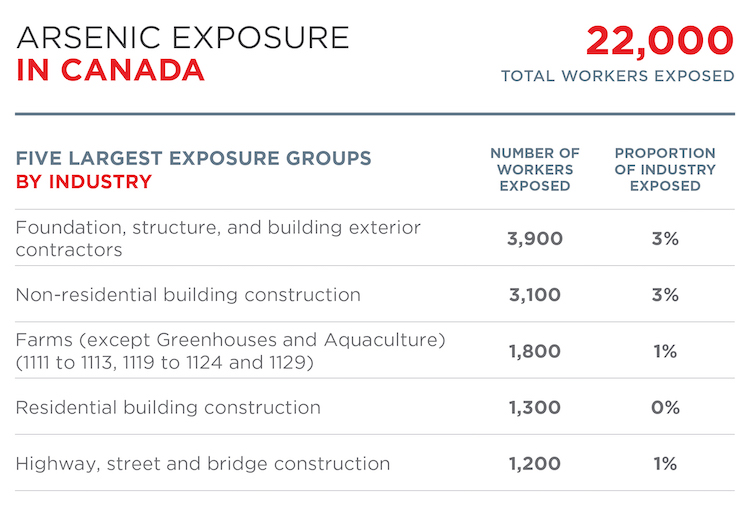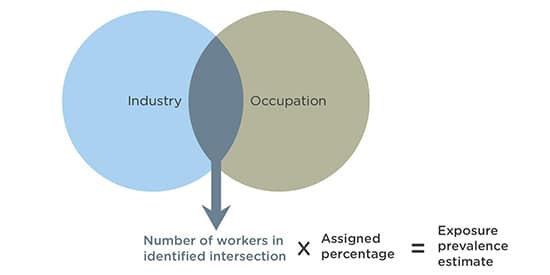Arsenic Occupational Exposures
Overview
Inhalation and dermal contact are the most important routes of occupational exposure.[1] CAREX Canada estimates that approximately 22,000 Canadians are exposed to arsenic at work; about half are exposed due to the use of arsenic in CCA wood preservatives.
READ MORE...
The industries with the highest number of exposed workers are foundation, structure, and building exterior contractors, non-residential building construction, and farms. These workers are primarily exposed to arsenic through CCA treated wood. The occupations with the most workers exposed include construction trades helpers and labourers, carpenters, machinists and machining and tooling inspectors, and contractors and supervisors, carpentry trades.
According to the Burden of Occupational Cancer in Canada project, occupational exposure to arsenic compounds leads to approximately 60 lung cancers each year in Canada, based on past exposures (1961-2001).[2,3] This amounts to 0.3% of all lung cancers diagnosed annually. Most arsenic-related cancers occur among workers in the manufacturing and construction sectors.[3]
Prevalence Estimate
Results show that approximately 22,000 Canadians are currently exposed to arsenic at work. Of these, 92% are male.
The industries with the highest number of exposed workers are foundation, structure, and building exterior contractors; non-residential building construction; and farms. Exposure in these groups primarily occurs through contact with arsenic-containing CCA wood preservatives. Workers may also be exposed to arsenic in the workplace in industries other than wood preservation. For example, exposure to arsenic occurs in the non-ferrous metal production and processing industry, as well as in iron and steel mills, where arsenic is produced as a by-product of the processing of other metals.
When exposure is examined by occupation, the largest groups of workers exposed to arsenic are construction trades helpers and labourers (4,700 workers exposed), carpenters (3,300 workers exposed), machinists and machining and tooling inspectors (2,000 workers exposed), and contractors and supervisors, carpentry trades (1,400 workers exposed).
The number of workers exposed to arsenic decreased by approximately 2,300 workers from 2006 to 2016 (a 9% decrease). This was driven by a decrease in the total number of workers in the sawmills and wood preservation industry, and the proportion of workers exposed within this industry.
Workers exposed to arsenic by industry in 2016

Workers exposed to arsenic by region in 2016
Click the second tab to view total number of workers exposed.
* = < 50 workers
Methods and Data
Our Occupational Approach page outlines the general approach used to calculate prevalence and exposure level estimates for workplace exposures.
Data Sources
Data used in developing the occupational estimates for arsenic were collected from several sources:
- The Canadian Workplace Exposure Database (CWED) contains over 700 measurements for arsenic exposure. These measurements were collected during the years 1981 to 2004 in Ontario and British Columbia workplaces.
- Canadian and US scientific peer reviewed publications that addressed arsenic exposure in Canada and the United States.
- Grey literature including technical reports from governments and international bodies.
Prevalence Estimate Method
CAREX defines exposure to arsenic as inhalation or dermal contact at work to levels above those encountered in the general environment (i.e. excluding exposure via ingestion of food or drinking water). In occupations involving wood preservation, exposure to arsenic includes direct contact with preservatives, as well as during the handling and processing of CCA-treated wood.
To determine the number of workers potentially exposed to arsenic at work, CAREX occupational exposure experts used methods previously established in other peer-reviewed CAREX projects in Europe. A series of steps were taken to assign exposure proportions to occupations and industries at risk of exposure to arsenic.

- Occupations and industries at risk of possible exposure to arsenic were identified using any combination of data sources described above.
- The total number of workers in each identified occupation and industry intersection was obtained from Statistics Canada 2016 census data.
- A percentage of workers exposed was assigned to that occupation and industry intersection. Percentages were determined by consultation with existing evidence in the data sources, previously established methods from the Europe CAREX estimates and the expert judgement of CAREX occupational hygienists.
- The number of workers in the identified group is multiplied by the assigned percentage to calculate the prevalence estimate of workers exposed to arsenic.
Sources
Subscribe to our newsletters
The CAREX Canada team offers two regular newsletters: the biannual e-Bulletin summarizing information on upcoming webinars, new publications, and updates to estimates and tools; and the monthly Carcinogens in the News, a digest of media articles, government reports, and academic literature related to the carcinogens we’ve classified as important for surveillance in Canada. Sign up for one or both of these newsletters below.
CAREX Canada
School of Population and Public Health
University of British Columbia
Vancouver Campus
370A - 2206 East Mall
Vancouver, BC V6T 1Z3
CANADA
As a national organization, our work extends across borders into many Indigenous lands throughout Canada. We gratefully acknowledge that our host institution, the University of British Columbia Point Grey campus, is located on the traditional, ancestral, and unceded territories of the xʷməθkʷəy̓əm (Musqueam) people.



